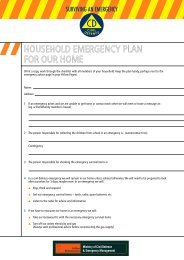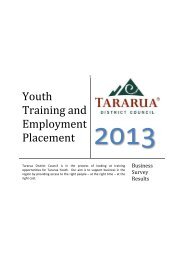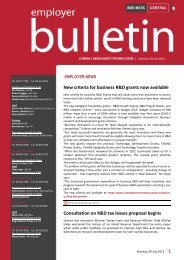Food Control Plan Checklist - Tararua District Council
Food Control Plan Checklist - Tararua District Council
Food Control Plan Checklist - Tararua District Council
- No tags were found...
Create successful ePaper yourself
Turn your PDF publications into a flip-book with our unique Google optimized e-Paper software.
The BasicsHealth and sickness1 Goal 2 Why?To prevent anyone who is carrying a communicable diseasefrom contaminating food.• <strong>Food</strong> can become contaminated by people who are unwellwith certain infections, or are carrying the organisms in oron their body.• Harmful microbes can be transmitted through a sickperson’s faeces (poo), vomit and in some cases other bodyfluids.3 How this is done1. No one (including a contractor, visitor etc) is permittedin a food-handling area if suffering from vomiting † ordiarrhoea*.• Anyone who has vomited or had diarrhoea in the 24-48hours prior to entering the food premises must reportit to .2. Any food handler ¤ who has had diarrhoea * two or moretimes, or any vomiting † within a 24-48 hour period mustseek medical advice and have a faecal specimen tested toidentify the cause of illness.• must ensure the foodhandler is excluded from the premises until they meetthe appropriate clearance criteria (see Records section).• is to determine whethera sick food handler is to be given safe alternative workthat does not involve direct contact with open food, orwith surfaces and equipment in any food area.Notes for ‘How this is done’* Diarrhoea other than that associated with conditionssuch as Irritable Bowel Syndrome, Crohn’s disease orulcerative colitis.†Vomiting in the absence of other obvious causes, eg,morning sickness or alcohol poisoning.¤<strong>Food</strong> handler any person who comes into direct contactwith food or the equipment or utensils used to preparefood (eg, cooks, waiting staff etc).4 What if there is a problem?If staff are not following this procedure find out why andretrain them if necessary.If someone vomits on the premises, clean and sanitise the area(including the cleaning equipment). Throw out any food thatmight have been infected and send the person home.Keep a vomit kit (disposable apron, gloves, bleach etc) handyto safely clean up any vomiting that may occur.Excluding food handlersSee Exclusion of infected persons for furtherinformation and clearance requirements (seeRecords).If you are uncertain whether a food handler maypose a risk, seek advice from an EnvironmentalHealth Officer at the local council.3. Any vomiting at work must be reported immediately to.• The food handler must be excluded immediately fromall food handling areas.• The affected area and all contaminated surfaces,including equipment and utensils must be cleaned andsanitised.• Any food that may have become contaminated must bedisposed of.will ensurethat this is done.4. No one with jaundice (yellowing of the skin) who issuspected of, or has, hepatitis A is allowed in a foodhandling area.5. No one is permitted to handle food if they have scaly,weeping or infected skin that cannot be totally coveredduring food handling.5Write it downWrite down in the ‘Sickness record’ (see‘Records’) when employees or others who visitthe premises are unwell and what action hasbeen taken (exclusion etc).Write down what you did when somethingwent wrong (eg, someone vomited on thepremises).<strong>Food</strong> <strong>Control</strong> <strong>Plan</strong> Version 3.0 2011B3







